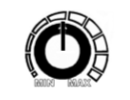Q5 Platinum™ Variable speed control dial
The Q5 PLATINUM Turbine is equipped with a Variable Speed Controller to adjust the speed of the motor. To decrease air pressure, simply turn this dial counter-clockwise. To increase air pressure, turn the dial clockwise.
How to use the speed controller
- Determine the viscosity of the ‘paint’. If it appears to be too thick, try thinning 10% with the appropriate thinner. Pour a smaller amount of this paint into the cup.
- Start off with the variable speed control set to full power (turned clockwise to the maximum).
- Adjust the spray gun fluid control to a medium spray and the pattern control knob set to a 6” – 8” sized fan.
- Spray a wet coat onto a horizontal board and allow to dry.
- Once the paint is dry, check the quality of finish. Is it smooth, fairly smooth, rough or bumpy?
Let’s assume the finish result is as desired – this means we do not need to thin the paint more. So to reduce overspray only, we can begin dialling down the pressure at the variable speed control dial. Re-test spraying at the reduced pressure to see if the quality of finish is affected. There will be a point where ‘orange-peel’ becomes more evident. This means we have gone too far and must turn the dial back to where there was no ‘orange-peel’. At this point, we have set the most efficient pressure for the particular paint you are spraying at that viscosity. The overspray and bounceback will be the least it can possibly be.
Now let’s assume that at the first test spray the finish quality was not acceptable – this means that the paint is too thick to be atomized properly even at full power. So some more thinning or the addition of a reducer (flow out additive) must be considered. Then re-test the spray as before. Continue this process until you achieve the desired result.
Points to consider
Always Measure Never Guess. It’s important to use a measuring cup when thinning your material. Included in each 5-stage Fuji system is an ‘Always Measure Pocket Booklet’ to track your results.
Certain additives such as Floetrol are not part of the thinning process. The purpose of most additives is to extend drying time.
Always ensure that you are testing on a horizontal surface as opposed to vertical. We don’t want to be fighting runs at this stage. Our aim is only to determine ideal paint viscosity and air pressure levels. Hold the spray gun no further than 6” – 8” away and spray a wet coat.
The quality of finish varies with particular ‘families’ of paints. Don’t assume you can achieve an automobile Grade “A” finish spraying Latex House Paint. Instead, use Auto Enamel/Lacquer for that job. The same goes for spraying fine furniture/pianos. You must use the appropriate coating.
The chart below displays realistic expectations and applications for the different settings of your Variable Speed Control Dial.
| SETTING | EQUIVALENT TO | PRACTICAL APPLICATIONS |
|---|---|---|
 |
5-Stage 9.5PSI | Automotive Clear Coats as well as heavier material such as Latex for larger jobs such as walls and ceilings |
 |
3-Stage and 4-Stage 7.5PSI | Lacquers, Polyurethanes and Latex when spraying cabinets, crown moulding, trim and furniture |
 |
2-Stage 5PSI | Stains, Lacquers and Polyurethanes especially when trying to create a softer spray or less overspray |
Please note that the practical applications are a general guide. It’s always best to set the Variable Speed Control Dial to suit your style of spraying as well as the environmental conditions that your projects are exposed to such as dust, temperature, humidity, etc.
As a general rule, if you experience too much overspray then reduce the air pressure. If you experience orange peel, then increase the air pressure. For the best efficiency, adjust dial to use the lowest pressure that will produce the finest results and atomisation.
